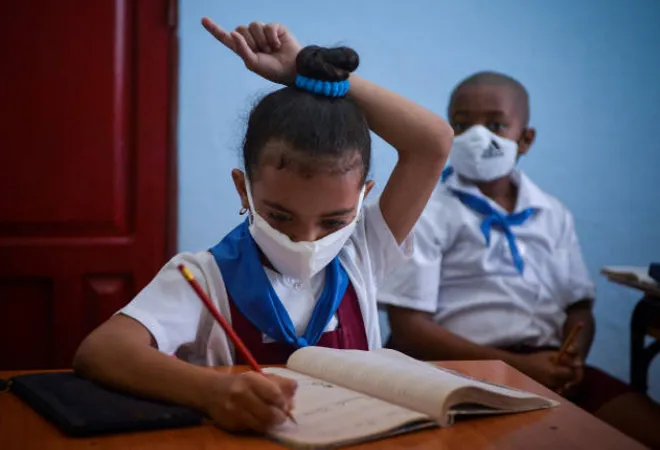
This article is part of the series Children and the Pandemic: An Analysis Across Countries
Having battled the pandemic for more than a year, we have witnessed the impact that it has had on multiple social groups and on the focus of this article—children. The authors aim to present a perspective about Latin America's measures, policies, and potential solutions. Some of them might be applicable for the entire region and others not.
Assessment
Before the advent of the pandemic, some countries in Latin America already had low proficiency levels as compared to other countries and regions globally when it comes to the education of children. Proficiency level is a standard gauged by determining if students are introduced to appropriate topics pertaining to their educational levels. However, when COVID-19 arrived, nation-wide lockdowns, nutrition levels, mental health issues, teachers' vaccination rate, and school opening rate, and access to remote tools and technology influenced the learning process heavily and negatively, especially on students from low income brackets.
Many children did not register for school in 2020 due to economic issues or health issues in their families. As time passes by, it will be more challenging to get those students back to school because they have already missed years of schooling or found other activities such as work to support their parents economically.
Analysis
1. School Desertion
Many children did not register for school in 2020 due to economic issues or health issues in their families. As time passes by, it will be more challenging to get those students back to school because they have already missed years of schooling or found other activities such as work to support their parents economically. The World Bank estimates that 120 million children will miss a year’s worth of classes due to the pandemic and that school desertion will increase by 15 percent. According to UNICEF, around 3 million students in Latin America will drop out of school indefinitely.
2. School opening
To decide whether to open schools or not is a complex policy decion to make, particularly when two core priorities clash: Learning versus the ability to keep everybody healthy and safe. Nevertheless, the efforts to replicate the school ecosystem at home are heteroenous and not standard. The school environment plays a huge role in interaction and socialisation, a crucial part of a child’s development. Yet, according to UNICEF, most of the countries in Latin America kept their schools partially closed. However, three Latin American countries: Costa Rica, Nicaragua, and Uruguay, have opened their schools, and six others are currently executing assessment and study recovery programmes. Nevertheless, the numbers show a colossal warning: 63 million children from Latin America and the Caribbean are currently affected by the closures—2 million are affected with total closing, 61 million with the partial closing.
According to UNICEF, most of the countries in Latin America kept their schools partially closed. However, three Latin American countries: Costa Rica, Nicaragua, and Uruguay, have opened their schools, and six others are currently executing assessment and study recovery programmes.
3. Remote access
Replicating the ecosystem at home with remote tools have only been partially successful at some levels where all the pieces of the environment are available: Good connectivity, an appropriate set of tools and the training to use them, a separate space to take classes, and access to somebody close by to ask questions, along with a methodology explicitly designed to be delivered in a remote environment, amongst other factors. But, unfortunately, only a few homes have access to all these variables. Of course, the most crucial variable is always connectivity. In the past years, the initiatives related to deploying the internet in the region helped reach 77 percent of students below 15 years old. But, again, the lower income population (those living with less than US $1.90 a day) have around 19 percent internet coverage in the Latin America Region. Today, access to dedicated or shared devices—tablets and laptops—with proper computing power might be a problem. Still, it can be fixed with a combination of cloud tools and other lower-range devices, such as smartphones, cell phones, and television broadcasts, amongst other available elements.
4. Health conditions
Nutrition and mental health are problems that might not manifest immediately but they affect the children directly. For example, many kids received food at school in the Latin American region. Now, without access to those rations, they struggle to keep healthy nutrition levels, and, thus, the stamina needed to maintain concentration and energy to study suffers. Fourteen million people suffered from hunger in 2020, and more than 3.4 million children will, as a result of it, face growth issues. 51.2 percent of children who live in urban areas do not have adequate space to access their remote classes, and they end up using spaces not intended for studying. Overcrowding is one of the variables influencing the study about mental health that UNICEF conducted amongst 9,000 kids and adolescents in nine Latin America and Caribbean countries. The initial findings showed that 27 percent of the respondents suffered from anxiety and 15 percent from depression; and just seven days prior to the research interview, their parents' current situation heavily influenced their mental and emotional state. In addition, 40 percent of those children did not ask for help when it came to their mental health.
Several countries in the Latin American region such as Colombia, Chile, Mexico, and Peru, shared Open Data through platforms to incentivise the collaboration of experts from the public and private sectors.
What can work?
Several countries in the Latin American region such as Colombia, Chile, Mexico, and Peru, shared Open Data through platforms to incentivise the collaboration of experts from the public and private sectors. The focus is still in infection and vaccination rates, as well as the availability of health services, but the pandemic’s impact on children and education and other priority development topics have not yet gotten the attention they need. The statistics, as we can see, are not hopeful. But we need these dire numbers to start planning a systemic approach.
The only way to tackle all these issues is a holistic view. It must be seen as a cross-collaboration between the health (nutrition, vaccination for teachers), communications (internet, devices), infrastructure (schools, commute), and education (flexible curriculum) sectors. There must be clear and measurable goals—a combination of short term goals (e.g., provide the few resources needed by middle-class students to fulfill their learning requirements) and long-term goals, which mainly involves what lower-income students will need to learn. The pandemic brought many new challenges to the already challenging educational environment. However, pre-COVID, the Latin American region had already made serious headway in that arena, but the pandemic has unfortunately forced it to restart from scratch. The region needs to use resources in a systematic manner and accelerate the much-needed change for the future of the education of our children.
The views expressed above belong to the author(s). ORF research and analyses now available on Telegram! Click here to access our curated content — blogs, longforms and interviews.




 PREV
PREV



